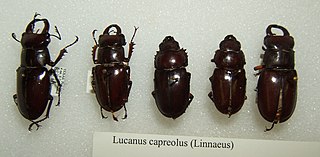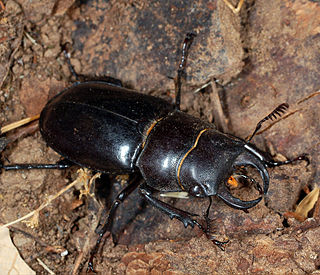
Stag beetles are a family of about 1,200 species of beetles in the family Lucanidae, currently classified in four subfamilies. Some species grow to over 12 centimetres, but most to about 5 cm (2 in).

The Lucaninae comprise the largest subfamily of the stag beetles (Lucanidae).

Lucanus cervus, known as the European stag beetle, or the greater stag beetle, is one of the best-known species of stag beetle in Western Europe, and is the eponymous example of the genus. L. cervus is listed as Near Threatened by the IUCN Red List.

Lucanus is a genus of stag beetles (Lucanidae).

Dorcus parallelipipedus, the lesser stag beetle, is a species of stag beetle found in Europe.

Lucanus capreolus, the reddish-brown stag beetle or pinching beetle, is a beetle of the family Lucanidae. The specific name capreolus is derived from Latin, meaning "roe deer". The name refers to the resemblance of the mandibles to deer antlers.

Lucanus elaphus, the giant stag beetle or elephant stag beetle, is a beetle of the family Lucanidae native to eastern North America. They are sometimes kept as pets.

Lucanus formosanus is a stag beetle which is endemic to Taiwan, and grows to a length of 45–80 millimetres (1.8–3.1 in). Like other species in the Lucanid family, L. formosanus exhibits distinct sexual dimorphism and subsequent external morphological allometry in males. Males of the species develop mandibles of various forms depending on geographic location; i.e. northern, central, and southern morphs.

Lucanus maculifemoratus is a beetle of the family Lucanidae. This species is known as Miyama stag beetle in Japan. These beetles have a light covering of golden hair on their back, mostly around the rear edges.

Lucanus tetraodon is a stag beetle of the family Lucanidae.
The Lucanidae are a family of beetles that include the stag beetles. The family can be further subdivided in a taxonomy. The classification presented here follows Smith (2006), with the exception of the tribal classification within the Lucaninae.
Elaphus occurs in these biological names:

Lucanus laminifer is a species of beetles of the family Lucanidae.

Paralissotes reticulatus, also called the New Zealand reticulate stag beetle, is a native species of stag beetle from New Zealand. Although they do have wings they are flightless.
Dorcus nepalensis is a stag beetle species first described by Frederick William Hope in 1831.
Lucanus Cervus, is a 1910 Russian short film directed by Ladislas Starevich. It was the first puppet stop motion animation in history, consisting of two preserved male stag beetles their legs replaced by wire, animated fighting one another over a mate.
Lucanus datunensis is a species of stag beetle endemic to the Tatun Mountain of Taiwan's Yangmingshan.It is first discovered in 1984. It is the smallest stag beetle in Taiwan and is an endangered species threatened by recent human activity.

Lucanus barbarossa is a species of stag beetle native to southwestern Europe and Northwest Africa.














